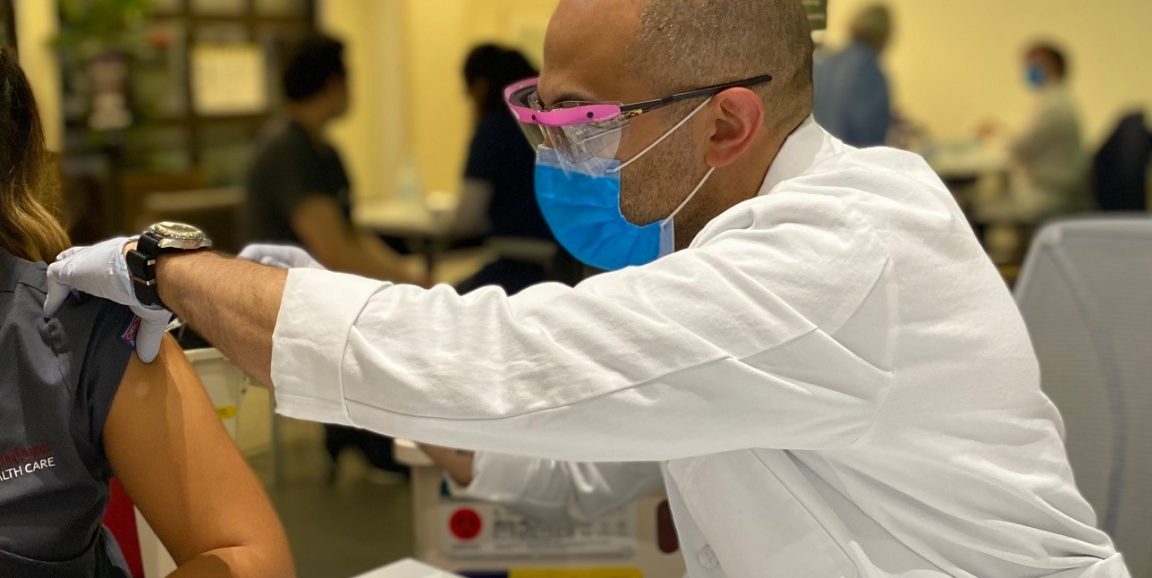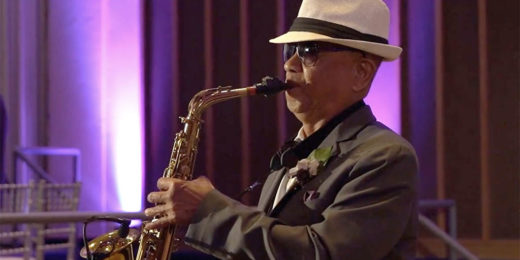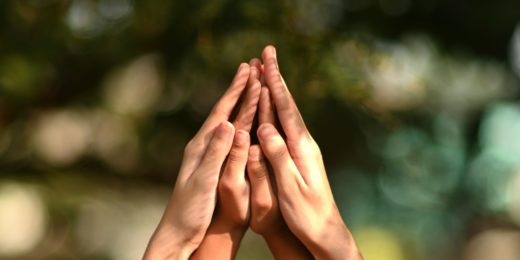When the first COVID-19 vaccines were approved near the end of 2020, employees from across Stanford Medicine stepped up, devoting weekends and working overtime to organize and staff vaccination sites.
"It started so suddenly. As soon as we had the vaccines it was like we needed to get them to our frontline health care workers yesterday," said Michaela Sullivan, RN, a director of hospital and clinic activations at Stanford Health Care who helped lead the charge to build Stanford's first COVID-19 vaccine site. "We had to quickly bring together all the right people and the right decision makers and then find folks who could actually make a vaccination clinic a reality."
Hundreds of employees -- from departments and units across Stanford Medicine -- went to work, transforming the atrium of the Stanford Hospital into a vaccination hub for health care workers. "People would just start to sob right in their chair because they were so relieved," said Eric Bernier, MSN, an administrative director of quality and operations who served as the nurse in charge during the first day of vaccinations. "They'd been waiting so long for a vaccine."
The network of employees has since grown to more than 500 -- a mix of new hires and staff opting to work overtime -- and seven new vaccination clinics have sprouted in the San Francisco Bay Area."We've all seen firsthand how easily COVID spreads," said Jackie Campbell, RN, a nurse for outpatient surgery who has spent many days off supporting the Palo Alto and Redwood City vaccine sites. "It a huge motivator to be a part of the larger eradication effort and I think it's so important that we do whatever we can to help."
Stanford Medicine has issued more than 414,000 doses of COVID-19 vaccines, reaching health care workers, members of the community, educators and more. As vaccine allocation allows, Stanford Medicine clinics are poised to dole out up to 10,000 shots per day.
All hands on deck
There's no manual for how to build and run a vaccine clinic in a matter of days, mid-pandemic. But with the guidance of Stanford Medicine's Clinical Activation and Ambulatory Care teams and other operational leaders, hundreds of employees navigated complex logistics, from securing physical resources -- like chairs, tables and computers -- to developing protocols to track vaccinated or partially vaccinated community members who came through the clinics each day.
Beyond the intense planning and organization that supports multiple vaccine clinics, the nature of the vaccines makes administration tricky. Pfizer and Moderna vaccines have to be stored at below-zero Celsius, which means they need to be defrosted by the thousands to meet demand.
"It's truly an all-hands-on-deck moment," said Erika Lim, RN, a nurse coordinator in Stanford's Department of Neurosurgery who began helping at the vaccine clinics as soon as they opened. Now, Lim administers shots to members of the community at the Emeryville clinic, where gratitude is the overwhelming sentiment. "Maybe I'm just a big softy, but it pulls at my heartstrings to see these older patients who, simply put, are frail. They're at risk and they're just so thankful to be able to get their vaccine and to finally have protection."
Reaching the community
Health care professionals make up the bulk of vaccine staff, but non-medical professionals from Stanford Medicine are stepping up, too. Michelle Mello, PhD, JD, a professor of law and of medicine, began to deliver vaccines in East Palo Alto in January. "I had had a pretty rough month, followed by the death of a dear colleague in the law school, and I was generally feeling pretty depleted. I just wanted to spend a day seeing something go right," said Mello.
During 2020, Mello's work involved analyzing missteps in the federal government's COVID response and policies, particularly in communities the pandemic is disproportionately impacting. "When I volunteered, it was really heartening to see that most of the people -- I'd say 95% -- vaccinated that day were from communities of color who had been more heavily affected by the virus. It made me so happy to see the vaccine going exactly where it was needed most."
Staff are trained to handle medical concerns and even help patients cope with nerves. Some express intense anxiety, said Candice Osuga Lin, NP, a nurse practitioner in the neurosurgery department.
Osuga Lin was administering a shot when one recipient began breathing quickly and heavily. "She had just received her dose and she turned to me and said, 'I'm panicking,'" Osuga Lin recalled. Medical professionals are on standby in case adverse reactions occur, but this required a different form of care. "I tried to help her think of something that's not antagonistic. So we started talking about gardening. I asked her about her bulbs and what she was planting, and that got her to focus on something not so intimidating."
A part of history
Most vaccine recipients express their gratitude, sharing their sentiments of relief and elation on social media through "vaccies" (a newly coined term that's part vaccine, part selfie). The overtime army of vaccine staff also share their gratitude for a chance to give back at a pivotal point in history. Vaccinations may not be the sole answer to the pandemic, but they are a critical one. "I think we all feel like this, in many ways, is history in the making," said Lim. "Forty years from now. I can tell my grandchildren that I gave shots to help end the pandemic. It's a contribution that's very humbling."
Photograph by Michaela Sullivan, RN, of Karthik Balakrishnan, MD, a doctor at Lucile Packard Children's Hospital, giving a COVID-19 vaccine to a colleague.






